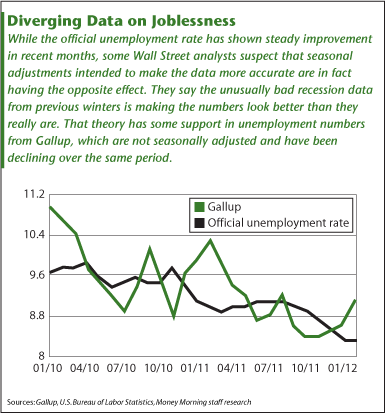A quirk in how the U.S. government calculates the unemployment rate has made the data look better than it is, some Wall Street experts are saying.
But in a stroke of bad luck for President Barack Obama, that same quirk will mask real improvements to the U.S. unemployment rate over the summer and into the fall, damaging his chances for re-election.
The official Bureau of Labor Statistics (BLS) unemployment rate has fallen from 8.9% in October to 8.3% in January. The number for February, released today (Friday), held steady at 8.3%.
"We think that the improvement over the last few months dramatically overstates the underlying improvement," Andrew Tilton, an economist at Goldman Sachs, told Reuters. "You will not see that rate of improvement going forward."
The sudden and rapid fall in the U.S. unemployment rate has generated much optimism among some analysts, who have hailed it as a sign of a strengthening economy. But it has mystified others, who began digging into the numbers for an explanation.
The answer lies in the "seasonal adjustments" the BLS makes to the unemployment rate to even out the spike in temporary summer jobs as well as the temporary loss of agricultural and construction jobs in the winter months.
But the degree of those seasonal adjustments is based on what happened in previous years. So the unemployment rates released over the past several months have been adjusted downward based on data from the horrific winter of 2008-2009.
If true, that means the real unemployment rate is probably somewhere over 8.5%, though still under 9%.
But those seasonal adjustments will have the reverse effect in the summer and fall, making it appear that the unemployment rate is rising when in fact it is falling. Economic research firm Nomura estimates the most dramatic effect could hit the October number, which will be reported November 2 - four days before the presidential election.
"You could see a rise in unemployment a few days before the election," Jeff Greenberg, an economist at Nomura in New York, told Reuters.
Voters are expected to react more to the overall trend of the U.S. unemployment rate rather than the actual number. If it appears to be rising rather than falling in the weeks leading up to the presidential election, such negative news could swing a close race.
The Real Unemployment Rate
Support for the theory that the seasonal adjustments have skewed the BLS data can be found in Gallup's independent unemployment numbers.
Gallup conducts a similar unemployment survey, but does not seasonally adjust its numbers. Earlier this week Gallup's U.S. unemployment rate for February rose to 9.1% from 8.6% in January. That followed a smaller increase of 0.1% in December; Gallup's rate was 8.4% in November.
 The BLS unemployment number, on the other hand, has declined for three straight months.
The BLS unemployment number, on the other hand, has declined for three straight months.
"Regardless of what the government reports, Gallup's unemployment and underemployment measures show a substantial deterioration since mid-January," writes Gallup chief economist Dennis Jacobe. "While there may be positive signs, the reality Gallup finds is that more Americans are looking for work now than were doing so just six weeks ago."
Indeed, the steep drop in the January BLS unemployment rate surprised many experts, all of whom had predicted little improvement not just for January, but for the balance of 2012.
For example, the Congressional Budget Office in January forecast an unemployment rate of 8.9%. The U.S. Federal Reserve predicted in January that unemployment would remain in the 8.2% to 8.5% range for the rest of the year. A USA Today survey of 48 economists produced a median estimate of 8.4% for the fourth quarter of 2012.
It's very likely the real unemployment rate is currently higher than the BLS figure, and further declines for the year are already baked in to the official number.
And still other factors, such as the reduced employability of the millions of long-term unemployed, will work against significant reductions in the U.S. unemployment rate this year.
Expect furrowed brows from optimistic economists anticipating unemployment rates continuing to edge down below 8% as the year goes on, and a lot of anxiety in the White House.
"The labor market is still fundamentally weaker than five years ago," Craig Dismuke, chief economic strategist at Memphis brokerage firm Vining Sparks, told Reuters. "We are still in a big hole. I'm not convinced that the unemployment rate will pick up."
Related Articles and News:
- Money Morning:
Bernanke Testimony to Congress: The World According to the Federal Reserve - Money Morning:
Jobs in America: The Ugly Truth Behind Those Unemployment Numbers - Money Morning:
Job Market Won't Normalize Until At Least 2023 - Money Morning:
Layoffs at U.S. Companies Portend Poorly for 2012 Prospects - MSNBC:
Employment data may be too good to be true - Reuters:
Job creation heralds stronger recovery
About the Author
David Zeiler, Associate Editor for Money Morning at Money Map Press, has been a journalist for more than 35 years, including 18 spent at The Baltimore Sun. He has worked as a writer, editor, and page designer at different times in his career. He's interviewed a number of well-known personalities - ranging from punk rock icon Joey Ramone to Apple Inc. co-founder Steve Wozniak.
Over the course of his journalistic career, Dave has covered many diverse subjects. Since arriving at Money Morning in 2011, he has focused primarily on technology. He's an expert on both Apple and cryptocurrencies. He started writing about Apple for The Sun in the mid-1990s, and had an Apple blog on The Sun's web site from 2007-2009. Dave's been writing about Bitcoin since 2011 - long before most people had even heard of it. He even mined it for a short time.
Dave has a BA in English and Mass Communications from Loyola University Maryland.



